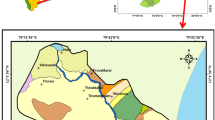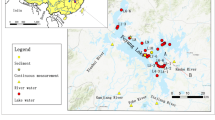Abstract
In arid regions of western China, water resources come from mountain watersheds and disappear in the desert plain. The exchange of surface water and groundwater takes place two or three times in a basin. It is essential to analyze the interaction of groundwater with surface water to use water resources effectively and predict the change in the water environment. The conventional method of analysis, however, measures only the flow of a stream and cannot determine groundwater seepage accurately. As the concentration of Radon-222 (222Rn) in groundwater is much higher than in surface water, the use of 222Rn was examined as an indicator for the analysis of the interaction between surface water and groundwater. Measurement of the 222Rn concentration in surface water was conducted to detect groundwater seepage into a stream in the middle Heihe Basin of northwestern China. Furthermore, the simultaneous groundwater flow into and out of a stream from the aquifers was quantified by solving the 222Rn mass balance equation, in which the losses of gas exchange and radioactive decay of 222Rn are considered. Meanwhile, river runoff was gauged to determine the exchange rates between surface water and groundwater. The result shows that 222Rn isotope can be used as a good environmental tracer with high sensitivity for the interaction between surface water and groundwater, especially in the fractured aquifer system, karst aquifer system and discharge basins.



Similar content being viewed by others
References
Banks D, Royset O, Strand T, Skarphagen H (1995) Radioelement (U, Th, Rn) concentrations in Norwegian bedrock groundwaters. Environ Geol 25:165–180
Bourg ACM, Bertin C (1994) Seasonal and spatial trends in manganese solubility in an alluvial aquifer. Environ Sci Technol 28:868–876
Chen L, Qu Y (1992) Water and land resources and their rational development and utilization in Heixi region. Science Press, Beijing, China (in Chinese)
Ellins KK, Roman-Mas A, Lee R (1990) Using Radon-222 to examine groundwater/surface discharge interaction in the Rio Grande de Manati, Puerto Rico. J Hydrol 115(1–4):319–341
Fan X (1981) Transformation of groundwater and surface water and rational utilization of water resources in Hexi Corridor region. Hydrogeol Eng Geol 4:1–6 (in Chinese)
Fan X (1990a) The characteristic of groundwater resources and environmental problems caused by overexploitation of water resources in the arid region of northwestern China. Hydrogeol Eng Geol 1:6–10 (in Chinese)
Fan X (1990b) The characteristic of groundwater resources and environmental problems caused by overexploitation of water resources in the arid region of northwestern China. Hydrogeol Eng Geol 2:10–15 (in Chinese)
Gao X, Li F (1990) Rational development and utilization of water resources in Heihe basin. Gansu Press of Science and Technology, Lanzhou, China (in Chinese)
Hamada H, Komae T (1994) Application of 222Rn to the analysis of the exchange between river water and groundwater. Radioisotopes 43:770–775
Hamada H, Imaizumi M, Komae T (1997) Methods of investigation and analysis of groundwater using radon as an indicator. Natl Res Inst Agric Eng 36:17–50
Kafri U (2001) Radon in groundwater as a tracer to assess flow velocities: two test cases from Israel. Environ Geol 40(3):392–398
Lee RW, Hollyday EF (1991) Use of radon measurements in Carters Creek, Maury County, Tennessee, to determine location and magnitude of groundwater seepage. US Geol Surv Bull 1971:237–242
McCarthy KA, McFarland WD, Wilkinson JM, White LD (1992) The dynamic relationship between groundwater and the Columbia river using deuterium and oxgen-18 as tracers. J Hydrol 135(1–4):1–12
McDonald MG, Harbaugh AW (1988) A modular three-dimensional finite-difference ground-water flow model. US Geol Surv Techn Water-Resour Inv, book 6, chap A1
Mitchell-Bruker SM (1993) Modeling steady state groundwater and surface water interactions. PhD Thesis, Indiana Univ, 94 pp
Modica E (1993) Hydraulic relationships between shallow groundwater subsystems discharging to surface water bodies and underlying regional systems (New Jersey). PhD Thesis, City Univ of New York, 223 pp
Otz MH, Otz HK, Siegel DI (2003) Surface water/groundwater interaction in the Piora aquifer, Switzerland: evidence from dye tracing tests. Hydrogeol J11(2):228–239
Rutledge AT (1992) Methods of using streamflow records for estimating total and effective recharge in the Appalachian Valley and Ridge, Piedmont, and Blue Ridge physiographic provinces. Am Water Resour Assoc Mon Ser 17:59–73
Silliman SE, Booth DF (1993) Analysis of time-series measurements of sediment temperature for identification of gaining vs. losing portions of Juday Creek, Indiana. J Hydrol 146(1–4):131–148
Sophocleous MA (1991) Stream-floodwave propagation through the Great Bend alluvial aquifer, Kansas: field measurements and numerical simulations. J Hydrol 124(3–4):207–228
Squillace PJ, Thurman EM, Furlong ET (1993) Groundwater as a nonpoint source of atrazine and deethylatrazine in a river during base flow conditions. Water Resour Res 29(6):1719–1729
Swain ED, Wexler EJ (1992) Coupled surface-water and groundwater flow model for simulation of stream-aquifer interaction. US Geol Surv Open-File Report 162:92–138
Wolf RJ, Helgesen JO (1993) Ground- and surface-water interaction between the Kansas River and associated alluvial aquifer, northeastern Kansas. US Geol Surv Water-Resour Inv Report 59:92–4137
Wu Y, Mu F, He Y, Lan Y (2000) Analysis of the interchange path between surface water and groundwater from Dingxin to Ejinaqi in Hei River Catchment, Western China. J Glaciology and Geocryology 22(1):73–77 (in Chinese)
Yoneda MYI, Takine N (1991) Location of groundwater seepage points into a river by measurement of Radon-222 concentration in water using activated charcoal passive collectors. J Hydrol 124(3–4):307–316
Acknowledgements
This work was supported by a grant from the National Natural Science Foundation of China (90102003), Innovation Project of CAS (KZCX1–10–03), Project of Education Department of China (00233) and the Innovation Project of CAS (KZCX210021). The authors wish to thank the anonymous reviewers for their reading of the manuscript, and for their suggestions and critical comments.
Author information
Authors and Affiliations
Corresponding author
Rights and permissions
About this article
Cite this article
Wu, Y., Wen, X. & Zhang, Y. Analysis of the exchange of groundwater and river water by using Radon-222 in the middle Heihe Basin of northwestern China. Env Geol 45, 647–653 (2004). https://doi.org/10.1007/s00254-003-0914-y
Received:
Accepted:
Published:
Issue Date:
DOI: https://doi.org/10.1007/s00254-003-0914-y




